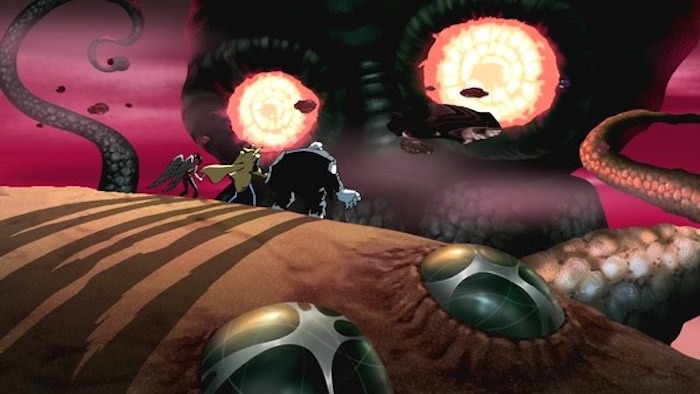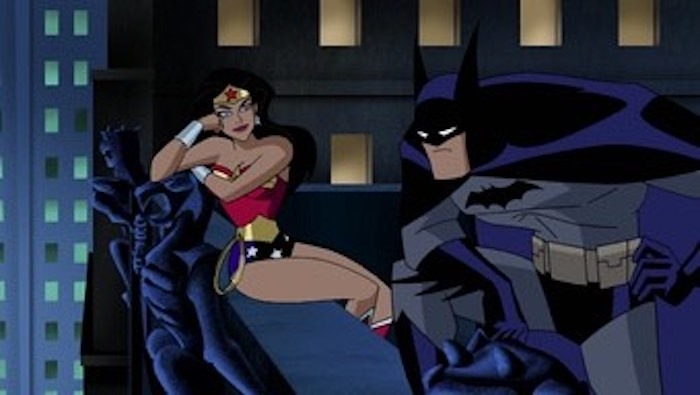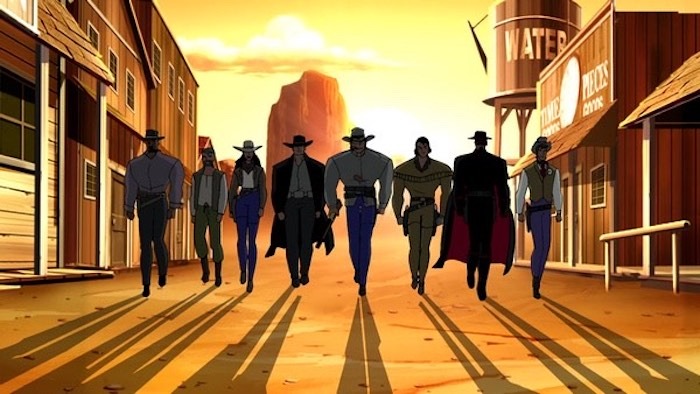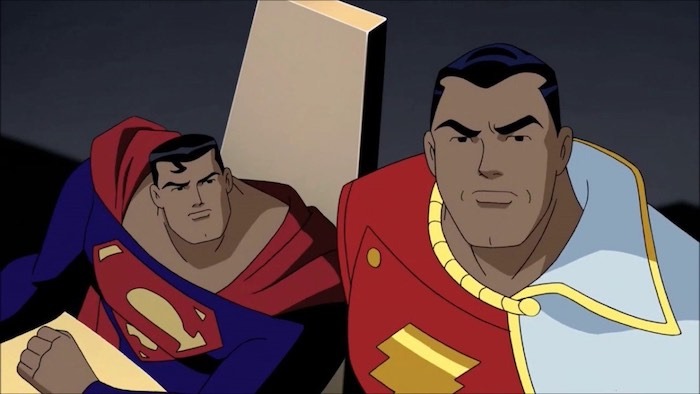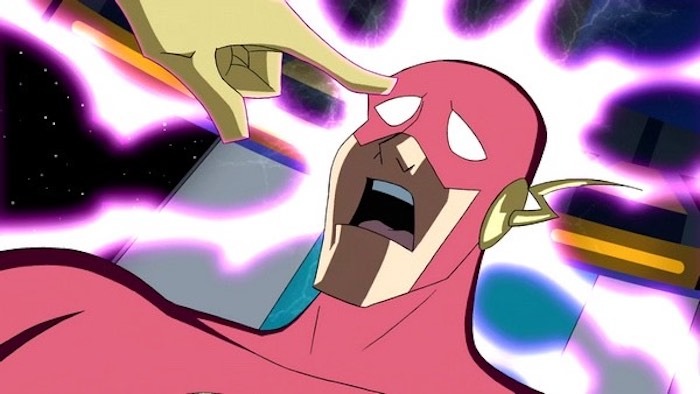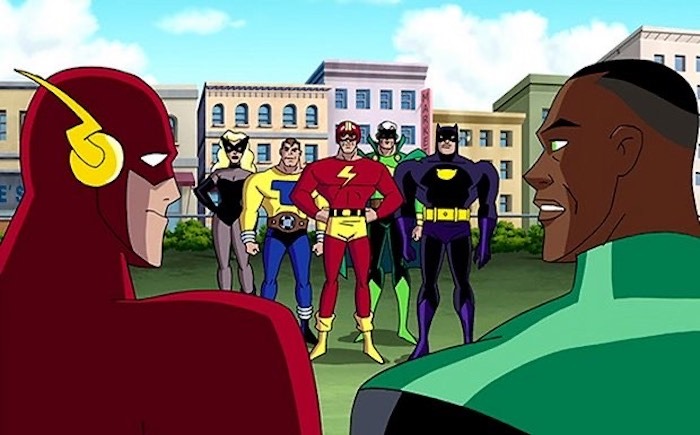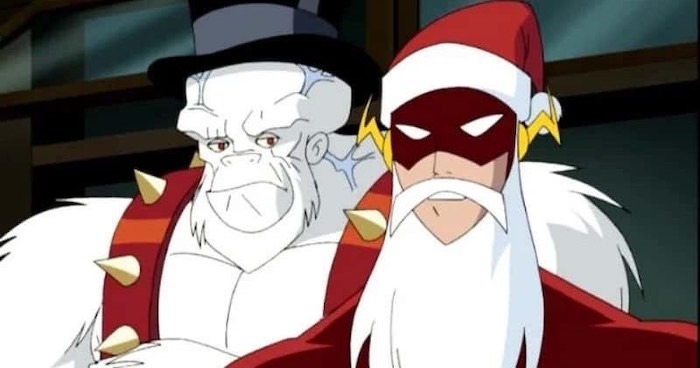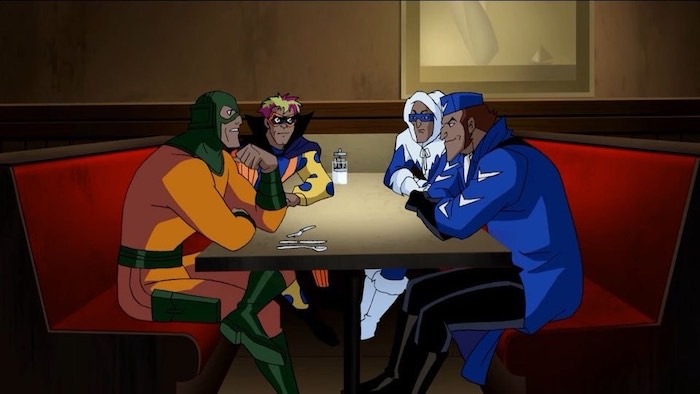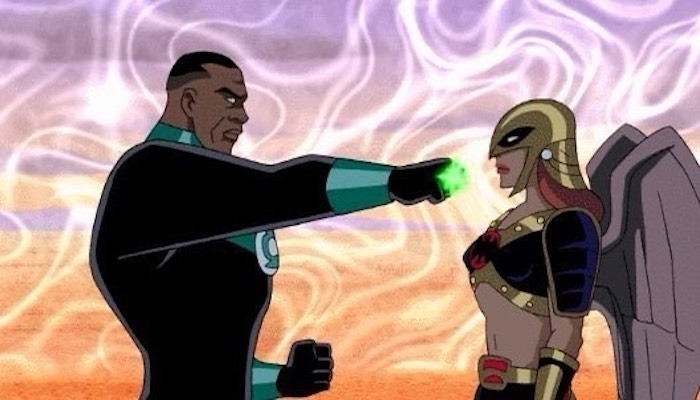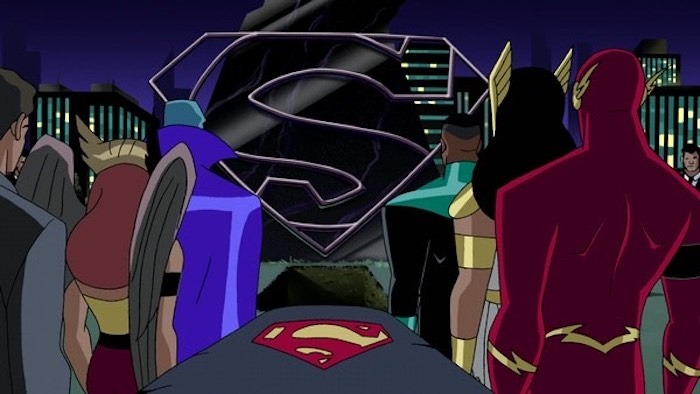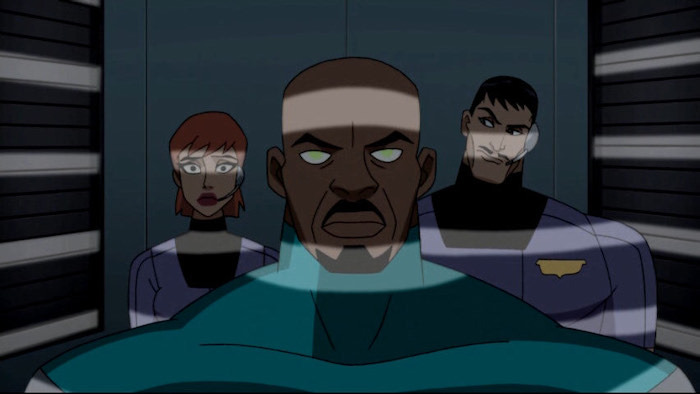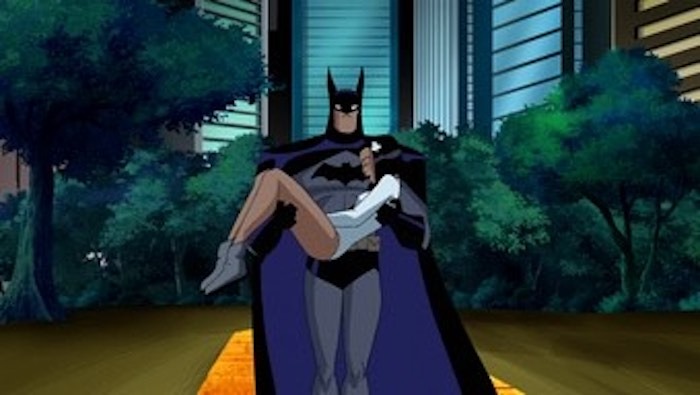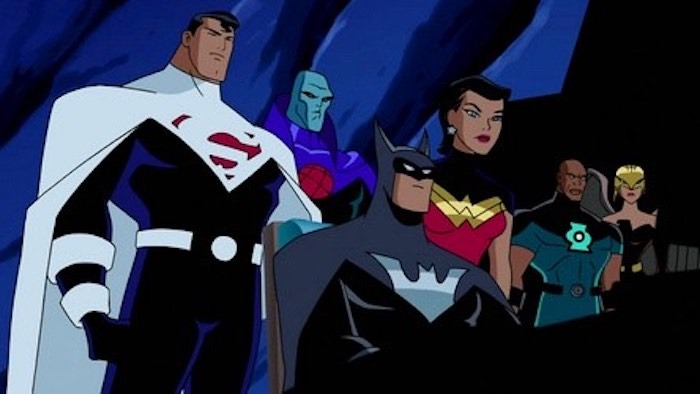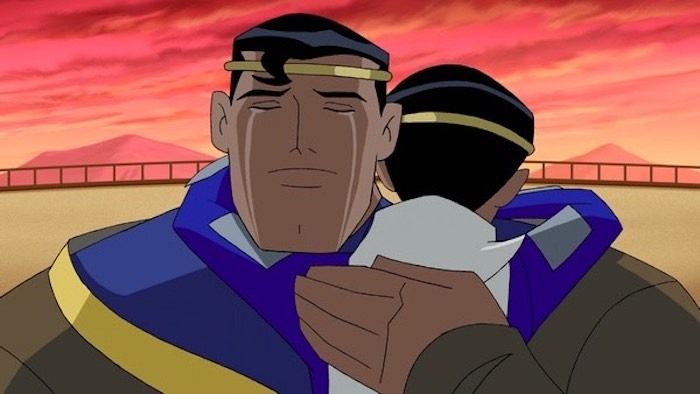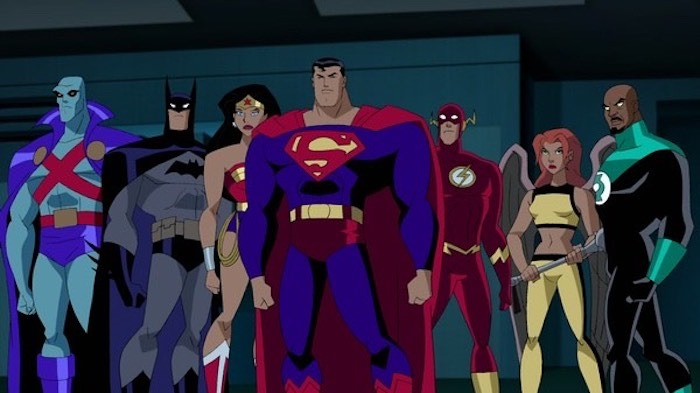The 15 Best Episodes Of 'Justice League' And 'Justice League Unlimited'
Zack Snyder's Justice League hit HBO Max last week, delivering a darker and edgier take on the DC superhero team. The filmmaker's directors cut is the result of a rallying cry from a loyal sect of fandom, who campaigned to see Snyder's official vision so the world could finally get the definitive Justice League movie they'd been waiting for.However, what fans may not know is they can already watch the best, most definitive version of the Justice League on HBO Max right now with the DCAU animated shows Justice League and Justice League Unlimited.This year marks the 20th anniversary of the Justice League animated series, the grand culmination of Bruce Timm's DC animated universe (or DCAU) which started a decade prior with Batman: The Animated Series. The success of Batman eventually paved the way for Superman to get his own animated series and share multiple crossovers with his Gotham neighbor. Timm's next project was the ambitious Batman Beyond, which took place 20 years after the events of Batman: The Animated Series, in which a darker and techno-punk Gotham became the home of a newer, younger Batman, Terry McGinnis, mentored by an older Bruce Wayne. The Timmverse culminated in DC's flagship title, Justice League, where Batman and Superman would enlist fellow heroes Wonder Woman, The Flash, Green Lantern, and the Martian Manhunter to protect the Earth from their ever-growing rogues' gallery in an orbiting Watchtower in space. The show would later rebrand itself after two seasons as Justice League Unlimited, and the roster would expand to almost every DC superhero imaginable. The show was inspired by Grant Morrison's run on the JLA comics and even had episodes scripted by several prominent comic writers, including J. M. DeMatteis, Gail Simone, Warren Ellis, and the late Dwayne McDuffie, the latter of whom would later become the main writer and architect of Justice League Unlimited. Not only is Justice League one of the finest superhero adaptations in any medium, but it remains one of the best animated shows of the last 20 years, leaving an everlasting impact on the comic book universe and animation as a whole. I know there's a crop of new comic book fans sprung from the recent boom of the Marvel and DC cinematic universes who were likely not old enough or just missed out on Justice League when it first aired. But thanks to HBO Max, both shows are now streaming and I want to share what I think are the best of the best the show had to offer. While the first two seasons of Justice League featured mostly stand-alone two-parter episodes, when it came back as Justice League Unlimited, it followed a more traditional serialized format with arcs spreading across multiple episodes.This is not an essential fast track of episodes, since I advise anyone who hasn't seen the show to watch it straight from the beginning. But here are the 15 best episodes of Justice League and Justice League Unlimited.
15. "The Terror Beyond" – Justice League, Season 2
Everyone knows the Justice League's most fearsome villains: Lex Luthor, The Joker, Gorilla Grodd, Darkseid, Cthulhu. Wait. What? Yes, there is an entire episode dedicated to the Old One itself and the League goes toe-to-toe with ole squidface in one of the more tear-jerking Justice League episodes. Oh, did I mention Cthulhu is voiced by Rob Zombie? Buckle in folks, it's a wild episode. You'll be surprised to know "The Terror Beyond” is a loose adaptation of a Marvel storyline featuring the Defenders as they battle the Undying Ones. The Defender team of Namor, Doctor Strange, and Hulk are rendered as Aquaman, Doctor Fate, and Solomon Grundy who are later joined by Superman, Hawkgirl, and Wonder Woman. The parallelism doesn't end there as the episode begins with a Thunderbolt Ross-like commander trying to capture an out-of-control Grundy before he is rescued by Aqua-Namor riding a giant sea-serpent. Aquaman needs Grundy, who is essentially a walking deadman, to be sacrificed in a ritual performed by Doctor Fate to prevent the coming of Icthulhu (writer Dwayne McDuffie wanted to use the name Cthulhu but assumed he couldn't have gotten the rights though; he could have as the name is in the public domain). What I love about "The Terror Beyond” is two things really: One, it introduces us to Dr. Fate, one of the best and slickest designed Justice Leaguers the show has to offer. He lives in a stone monument called The Tower of Fate alongside his wife, Inza, as he welcomes lost souls in need of purpose. He's an awesome addition and would be more prominent in Justice League Unlimited and in non-DCAU shows, The Brave and the Bold and Young Justice. Two, all the Lovecraftian imagery on display is a joy to behold. When the heroes enters Icthulhu's realm, up becomes down as they try to traverse this nightmare void, battling creatures who have mouths in their hands (this leads to one of the episodes best lines where Grundy shouts "GRUNDY HATE SCREAMING MAN!"). Icthulhu's Terror enters Aquaman's domain as a horde of unspeakable creatures rage war against Aquaman in a fantastic underwater battle.Solomon Grundy is an interesting character to headline an episode around, as he's mostly a rampaging vegetable with a limited vocabulary. He flexes between friend and foe throughout the series, but he carries a softness that attracts Hawgirl in one of the show's more unique and compassionate friendships. Underneath all the Lovecraftian insanity the episode throws at us, this is a sweet tender episode about Hawkgirl coming to a realization about faith and sacrifice. Hawkgirl's people, the Thanagarians, used to worship the Old Ones and then stop believing in them, which pissed off the mighty Icthulhu. Grundy, who remembers he used to be an old west vigilante who was brutally murdered, wants his soul back and believes Icthulhu has it. Bringing faith to a kid's show is always a tricky tightrope act, but McDuffie performs it gracefully in showing an understanding between having faith in a higher power versus a faith in being a strong-willed person.
14. "This Little Piggy" – Justice League Unlimited, Season 1
I don't know what it says about me that my favorite DC movie of the past decade is Teen Titans GO! To the Movies. Alongside The LEGO Batman Movie, the movie is earnest about how goofy it is, and understands in order to poke fun at your own genre, you have to truly love it first. Ever since DC took a more "darkness, no parents" approach to its slate of movies, it has sparked a cultural war among comic book fans in how overly serious they want their superhero movies to be. Let's face it, comic books are inherently silly. They're fun escapist stories about people with extraordinary abilities who wear ridiculous costumes to fight bad guys who wear even more ridiculous costumes. The beautiful thing about the comic book industry is it's wide enough for all writers and artists to play around with these characters without there being one, true "correct" way to tell a story about a man who dresses like a bat. I can love The Dark Knight Returns and the '60s Batman show on equal terms. Justice League Unlimited understands that tonal balance better than many, which is why it can shift from a serious episode like "For The Man Who Has Everything" to "This Little Piggy," where Wonder Woman turns into a pig and Batman sings the blues."This Little Piggy" is one of Justice League Unlimited's lightweight episodes alongside "Kid's Stuff" and "The Greatest Story Never Told." It's a divisive episode amongst fans primarily for its ridiculous premise and the way it defies normal conventions. If you're all into the Snyderverse aesthetics of how superhero stories should be like, this episode is likely not going to appeal to you. Superhero animation legend Paul Dini returns to write this one after his delightful "Comfort and Joy," but "This Little Piggy" is full of his trademark Dini-isms. Let's see what we got: Lots of Zatanna? Check. Being horny on main? Check. Unused background characters getting their moment in the spotlight? Check. Not one, but TWO musical numbers? Oh yeah, this is a Dini episode alright. There's nobody else other than Paul Dini I would trust to make an episode this wacky given his years of experience writing in this universe. This episode doesn't work unless you have the developing relationship between Batman and Wonder Woman established earlier on in the series. Diana clearly wants to move to the next level, but Batman explains that dating within the team leads to disaster and an immortal princess and a rich kid with issues' don't pair well. Of course Diana thinks he's full of shit. When Diana gets transformed into a pig by the sorceress Circe, Batman enlists the help of his old friend Zatanna to reverse the spell. When her attempt fails, they turn to other measures, but still try to keep the League from finding out about Wonder Pig. It's a wild episode. Wild as in Batman takes a trip to Tartarus and meets Themis, who brings in Circe's former roommate, a chain-smoking Medusa, who offers to reveal the location of Circe in return to shave off 300 years from her sentence. Wild as in bringing in animal tracker extraordinaire B'wana Beast, who flirts with Zatanna and chatters up with pigs in a pork processing plant. Wild as in Wonder Pig deflects a shotgun blast with her golden pig bracelets. You get the idea. All of this climaxes in a musical number where Kevin Conroy gets belt out his pipes like never before. Is this episode ridiculous? Sure, but it's also entertaining and is a fun reminder that every episode doesn't need to deal with Darkseid taking over the world. Sometimes you just need a nice story about a bat and his pig.
13. "The Once and Future Thing" – Justice League Unlimited, Season 1
Justice League shows loves to end their first seasons with crazy time travel adventures. For their first season one finale, the League was sent forward to a distorted future where the Axis won World War II and now have to go back in time and correct history from the immortal and new Fuhrer Vandal Savage. In Justice League Unlimited's season 1 finale (the only two-parter in JLU's three seasons), time travel takes our heroes to the Wild West of 19th century Oklahoma and then 50 years forward into a familiar-looking future Gotham. I love time travel stories, especially within the comic book world, because you don't have to think too hard about the logic and it's a fun excuse for characters to bump into characters they wouldn't normally meet.The first part, "Wild Western Tales,” has Green Lantern, Batman, and Wonder Woman chasing after a lowly two-bit thief named David Clinton who uses time travel to steal artifacts throughout history to impress his nagging wife. Clinton attempts to steal Batman's utility belt, but he gets caught and they get sucked into a time portal taking them back to the Wild West. This allows the trio, now all spurred and saddled up, to team up with All-Star Western heroes such as Jonah Hex, Bat Lash, El Diablo, and Ohiyesa "Pow Wow" Smith. There's lots of fan service on display, rewarding old school comic book readers by showing love to an unsung group of heroes confined to a specific time when Westerns were the superhero stories of yonder. Dwayne McDuffie dives headfirst into this Western sandbox, creating a fun throwback playing with all the familiar tropes, including our heroes riding out set to a classic Elmer Bernstein riff on the Justice League theme. Of course this being a time travel story, there's some time-ripping shenanigans like cowboys riding dinosaurs and robots with top hats to keep our heroes on their toes before they set off to their next destination.The second time-jump takes Batman, Wonder Woman, and Green Lantern into the future, where the only remaining survivors of the league are Batman (Terry McGinnis), Static, and Warhawk. Upon seeing John Stewart, Warhawk lets out a cry of "Dad?", revealing he is the future son of John and Shayera. Experiencing the Batman Beyond universe once again is a great surprise for DCAU fans, especially seeing the return of the Jokerz, a homicidal gang seen only in the excellent DCAU movie, Batman Beyond: Return of the Joker. While riding high in the Old West had its blend of action and humor, part two carries higher stakes and a darker tone, as Clinton (or Lord Chronos as he now calls himself) messes up with the space-time continuum where the universe starts to fade out of existence. There's still a lot of fan service-y moments, like Batman playing good-cop-bad-cop with his older self and John Stewart time-shifting into a fan-favorite Lantern corps. Executing fan service can be tricky, especially in a comic book adaptation where it's expected, without being overly gratuitous. The show finds balance between giving what the fans want while also making sure it makes sense in the story they want to tell. There's no "wink-wink" or elbow-nudging done here. It's all out of genuine love for the characters and their stories.
12. "Clash" – Justice League Unlimited, Season 2
What makes Lex Luthor such a formidable foe for the Justice League? A single punch by Superman would end him, but nevertheless he still finds himself at the top of the villain hierarchy. Sure, he sometimes battles in a nanotech robot suit, gets super strength, or merges with Brainiac to be a more physically opposing opponent, but his greatest strength has always been his mind. He takes joy in manipulating the "Truth, Justice, and American Way" ideals of the League by taking the line they struggle not to cross and smearing his foot over it. Clancy Brown is the quintessential Luthor, who doesn't need a jar of piss to be threatening, as his study tenacity and smooth demeanor is enough to find the perfect balance of charm and menace. He's been the bedrock of the entire series, creating the schism between the trust between League and the people they have sworn to protect."Clash" happens on the eve of the Cadmus arc, and there's no better time to light the fuse by introducing Captain Marvel (or Shazam as he is now referred to) to hold a mirror up to Superman. Captain Marvel is actually a young boy named Billy Batson, who shouts "shazam!" to turn into a superhero with strength rivaling Superman. While he grows in size, he still has a child-like view of the world, and has all the boy scout characteristics normally associated with Clark. Captain Marvel can't see beyond black and white, and believes Luthor has changed for good, endorsing his run for president, which sets alarms off for the League, especially Superman. They believe the League should remain neutral and stay out of politics (yet politics keeps finding a way to stay with the League). Luthor uses this rift to stage a charitable event for his new project "Lexor City," which promises affordable housing for low-income families. When Superman attends, he scans a mysterious device with a timer ticking down several floors below the surface. Luthor says it's nothing but a power generator, but Superman doesn't buy his bullshit, which leads to the titular clash between Captain Marvel and Superman.Boy, this fight is brutal and it's hard to root for Superman as he pummels Captain Marvel to pieces, unaware they are mere pawns in Luthor's grand chessboard. The brawl is everything Lex wanted, a showcase of how violent these super-powered individuals can be as they level all of Lexor City (all purposely evacuated). Dan Riba's direction makes sure you feel every punch and blow and even homages the two fighting in the comic Kingdom Come. In the end, the real clash is between principles, as Superman is humiliated for destroying the city over a false warning, but deep inside he knew he had every right to not trust Luthor. Batson leaves the League (this is sadly his only DCAU appearance), upset how the Justice League have stopped being heroes and believing people can change, but his naivety blinds him from the truth that good-hearted people are sometimes the easiest to turn.
11. "The Great Brain Robbery" – Justice League Unlimited, Season 3
A superhero twist on the Freaky Friday formula where The Flash and Lex Luthor switch bodies was not something I expected to see in the middle of the third and final season of Justice League Unlimited, but often the most ridiculous episodes are the most entertaining. Justice League is a team-based show, and even in world-ending scenarios, the characters can't help but riff on each other or to comment on the absurdity of the situation. Most of the offhand jokes come from The Flash, the self-proclaimed comic relief of the team, and the only one who seems to be having the most fun when he's not awkwardly flirting with other heroes or selling out with his energy bars. "The Great Brain Robbery" pits Flash's foolishness against the unforgiving and vainglorious Lex Luthor, who has overtaken Grodd as head of the Legion of Doom and also steals his girlfriend, Tala, who tries her best to warm up to the coldhearted villain. When Doctor Fate tries to locate the whereabouts of Grodd through Flash's mind, his mystical powers accidentally intercept Lex's own mind-probing of Grodd, which causes the minds to switch. There's no real sound logic to it (which is why it's perfect to get Fate involved), but it serves as a perfect scene-stealing opportunity for Clancy Brown and Michael Rosenbaum to play against type. Of course it wasn't really against type for Michael Rosenbaum who notably already starred as Lex on the hit show Smallville. His Flash-Lex hits all the humorous beats as he fumbles around like an idiot all while trying to play the role of an evil mastermind. Meanwhile on the Watchtower, Doctor Fate immediately figures out Lex-Flash isn't really The Flash and Lex has to adapt on the fly using Flash's superspeed powers to find a way out. Luthor's take on Flash is more sinister than awkward. He shows why Flash is one of the more unstoppable Leaguers when his powers are at full potential.Let's be real. We know why this episode is among the 15 best episodes. It's for two scenes that take place in a bathroom. Even non-watcher have probably seen these scenes retweeted or shared on their social media. The first has Flash-Lex in the bathroom ready to leave when Polaris stops him, asking him if he's going to wash his hands. Flash-Lex pauses for a bit, smiles and says "No. Because I'm evil." It's hilarious in a "this-is-how-a-kid-thinks-a-grown-up-acts" in terms of villainy. The second has Lex-Flash staring at himself in a mirror, catching his breath, and realizing this brain-mishap will finally let him know the secret identity of The Flash. He takes off the mask, stares at the red-headed person in the mirror and says, "I have no idea who this is."
10. "Legends" – Justice League, Season 1
When WandaVision was rolling out, I couldn't help notice the striking similarities between Marvel's show and the Justice League episode, "Legends." After all, shows are about superheroes trapped in a mind-controlled Pleasantville-type small town with sinister undercurrents. Instead of coping with grief by recreating Dick Van Dyke reruns, Justice League reshapes its world through the lens of the Golden Age era of comic books.During one of their everyday rumbles with Lex Luthor, Green Lantern, Hawkgirl, Flash, and Martian Manhunter get zapped into an alternate dimension where everything is a bit too peachy keen. They come face-to-face with a superhero team called Justice Guild of America, which turn out to be the same comic book heroes that Green Lantern read as a kid, inspiring him to be a hero. These superheroes are a hodgepodge of the real Justice Society of America created by Gardner Fox (who this episode is dedicated to), but DC would not let them use the real names. On the surface level, this episode is a cornball delight; a cheesy love letter to the Golden years of comics where superheroes would save cats from trees, and villains like the Music Master would fight with his accordion and drive a clarinet car. The whole episode is an Easter Egg paradise for comic book fans.J'onn J'onzz feels a malefic vibe beneath all the goofy puns and coincidental dangers, like a bus full of nuns on a collision course with a TNT factory. The second part of the episode reveals this town's hidden intentions and turns into a poignant and tragic look at letting go of our nostalgia and the sacrifices that come with being a hero. This isn't a glossy look at our childhood obsessions, but a reminder of how dangerous it can be to hold on to the past and not move on. Even the culprit behind this wistful wonderland represents a dangerous commentary about escapism into fantasy. We often lose ourselves in comics and other stories that comfort us from the terrors of reality. Escapism can be a tonic that washes away all our woes and troubles, but its effects can be temporary, and they can be addictive. The Justice Guild understands this important difference in their final stand and Green Lantern learns a hard lesson on what a real hero must do in the face of adversity.
9. "Comfort and Joy" – Justice League, Season 2
We all have our favorite go-to Christmas special that we watch around the holiday season. One TV holiday special I make sure to watch on every Christmas Eve is the Justice League episode "Comfort and Joy." This isn't the first time the DCAU has dabbled with the holiday spirit, as Timm and Co. already did two holiday specials prior with "Christmas with the Joker" and "Holiday Knights" in both versions of Batman: The Animated Series. It may be odd to put a light and fluffy holiday special amongst heavy-hitter episodes where the stakes couldn't be higher, but "Comfort and Joy" deserves every acclaim and more, as it really is a beautiful exhibit of how the Justice League has morphed from a superhero team into a family."Comfort and Joy" is the only stand-alone one-part episode of the first two seasons, acting as a palate cleanser between action-oriented and plot-heavy episodes. Here, we get three light-hearted intersecting vignettes featuring Hawkgirl starting a brawl at a Cheers-like alien bar while exploring her romance with Jon, Flash and the Ultra-Humanite staging their very best Jingle All The Way adaptation, and finally, Superman bringing J'onn home to spend Christmas Eve with Ma and Pa Kent. While the first two stories offer a lot of action, humor, and heart, the closing story with Clark and J'onn is the emotional centerpiece of the episode and the reason it sticks with me.The Justice League is littered with lonely outcasts who have suffered great loss. None of them are bigger outsiders than J'onn J'onzz, the Martian Manhunter, the last of his species. He joined the League without a home or a family. Superman, who knows a thing or two about being an alien outsider, invites him over to spend Christmas with his Earth family, the Kents. Martha and Jonathan are immediately fond of J'onn, who try to warm him up and make him feel at home. There's some similarities between J'onn and another famous green Christmas doubter, but J'onn isn't a Grinch, just someone who yearns to find his place in this foreign world. This whole segment is full of cozy moments, and it's a treat to watch Clark act like a kid again with his parents. Who knew Superman still believes in Santa or that Ma and Pa have to wrap his presents in lead due to his habit of peeking. There's also a nod to J'onn's Oreo obsession and even a rare Streaky appearance! This episode was penned by DCAU veteran Paul Dini, who understands these characters inside and out. He has a gift getting to the heart of the relationships between our heroes and their greater purpose. Anyone who feels alone or lost during the Christmas season will resonate deeply with this holiday classic.
8. "Flash and Substance" – Justice League Unlimited, Season 3
One of the greatest episodes of television ever made is Batman: The Animated Series' "Almost Got 'Im" about a select company of Batman's most infamous villains hanging out at a bar and swapping stories. The Joker, Poison Ivy, Two Face, The Penguin, and Killer Croc all share their past skirmishes with The Dark Knight, each trying to one-up the other. It's apropos that the other big DC animated show would pay tribute with "Flash and Substance." But instead of Batman's rogue gallery, it's the villains associated with The Flash. Captain Cold, Mirror Master, Captain Boomerang, and the Trickster are all enjoying (non-alcoholic) drinks together at Central City's bar for villainy, reminiscing about their failed encounters with the Flash. Instead of flashing back, they decided to team up together and finally put an end to the Scarlet Speedster by attacking him at the grand opening of The Flash Museum for Flash Appreciation Day. Despite being one of the founding seven members of the Justice League, The Flash has rarely been the focal point of an episode. He's played a part in episodes like "The Brave and the Bold" and "Eclipsed," but none of them offer any insight of who he is beyond being comic relief. We don't even know which Flash he was until the season 2 finale where he takes off his mask and viola, he's Wally West! Then he completely disappears for the first season of Justice League Unlimited. "Flash and Substance" is the first real Flash-centric episode and it comes midway through the final season. Both "Flash and Substance" and "The Great Brain Robbery" finally give Wally the love he deserves. Of course, we are now seven seasons deep into a Flash live-action TV show with an upcoming movie on the way, so it's Flash Appreciation Day all the time now.What I love about The Flash is how much people can't help but like the guy. Unlike the rest of the team, he's not an outcast or has a tragic backstory (unlike his uncle Barry). Batman, who believes in the power of reformation, identifies with Flash's endurance in bringing a community together rather than tearing it apart. In what is probably my single favorite scene in the entire series, the Flash returns to the bar to find The Trickster (played by Mark Hamill) sitting alone, moping to himself. Flash warmly greets him, refers to him by his real name, and tells him he's been off his meds because "you're wearing the costume again." It's a funny moment, but deeply empathetic at the same time, showing genuine concern for his adversary's mental health. The DCAU was revelatory in its depiction of sympathetic villains struggling with their own pain, and The Flash gives us a sympathetic window into that.
7. "Starcrossed" – Justice League, Season 2
"Starcrossed," the season 2 finale of Justice League, has all the makings of a sweeping epic episode to match its lofty Shakespearean title. So epic that Warner Bros. packaged all three parts of the finale together and marketed it as its own DCAU movie. Bruce Timm was unsure if the show would be picked up for a third season, so they structured the episode as a possible final episode. While most of season 1 and 2 had been stand-alone adventures, one consistent thread has been the development of Hawkgirl and her relationship with John Stewart. They've been in a constant flirtatious squabble all season until finally all the steam was let out at the end of "Wild Cards." John and Shayera play the titular star-crossed lovers as their budding romance is disrupted when the assumed-missing Thanagarians arrive to warn that Earth is in serious danger of an impending attack. The Thanagarians convince the world leaders to build a device that will engulf the Earth in a giant forcefield to ward off any intergalactic attack. Oh, and the leader of the Thanagarians is Hro Talak, Shayera's promised betrothed and she has been a Thanagarian spy all along. Whoopsie.What we get is a mish-mash of Romeo & Juliet and Mark Waid's JLA: Tower of Babel comic, where friends are betrayed, hearts are broken, and loyalty is forever doubted. If Green Lantern is Romeo, Shayera is Juliet, Hro is Paris, then I guess to stretch the analogy further, Batman is Mercutio, who is like, "a pox on both of your houses" and tries to uncover the truth alone. What he finds out is the Thanagarians are up to no good and this device is actually a weapon to destroy Earth, not save it. If you think I'm spoiling too much, this all happens within the first 15 minutes of the first of three episodes. The remaining time has Shayera question whose family she wants to belong to as she flip-flops allegiances further dividing the rift between both her, John, and Hro.Once the Thanagarians enforce a police state, the Justice League is forced to go undercover using their real identities in a great scene reminding me why I love this show so much. Flash is worried about knowing each other's secret identities, but Batman shows why he's Batman and takes off his mask and reveals he's Bruce Wayne, Superman is Clark Kent, and (to his astonishment) Flash is Kid Flash himself, Wally West, red hair and all. This moment was the first confirmation that the DCAU's Flash was indeed Wally. It's just fun seeing the League in their street clothes (and J'onn in human form) considering how rarely their non-superhero lives are shown in the show. As one romance is on the verge of breakdown, a new one blossoms between Bruce and Diana, leading to a new power couple in Justice League Unlimited. "Starcrossed" is one big epic feast of an episode with plenty of humor, action, and tragedy (not to mention a bad pun here and there) to cap off an incredible season.
6. "Hereafter" – Justice League, Season 2
In the early '90s, DC held their yearly "Superman Summit" to discuss how to increase public interest in the face of waning sales for the Man of Steel. Superman hadn't been relevant since John Byrne left DC in 1988 and fans gravitated to more "Xtreme" heroes like Wolverine, The Punisher, and Deadpool. The writers agreed they needed a major shakeup to keep Supes exciting again. Enter: The Death of Superman. Originally pitched as a joke by Jerry Ordway, DC decided to go forth with it, examining what a world would look like without a Superman. Mostly seen as a gimmick to boost sales, the three-part crossover story shaped the future of the '90s comics for better or worse. The ripples were eventually felt in the DCAU with the Justice League episode "Hereafter." The smartest thing writer Dwyane McDuffie did was "kill" off Superman within the first 10 minutes of this two-part episode, making it clear that this won't be a straight adaptation, but an examination of the grief felt by the rest of the League and the entire world.So which one of Superman's most dastardly villains finally got the best of him? Lex Luthor? Brainiac? Darkseid? How about... Toyman? Yes, Toyman, one of Superman's oldest foes, but never taken seriously. The DCAU's version is his best incarnation; a man trapped in an expressionless porcelain doll who zaps Superman with an energy blast disintegrating his body. As everyone reels in shock from what just happened, Toyman raises his arms in glee and shouts, "Superman go bye-bye!" It's a harrowing moment and the rest of the episode deals with ramifications on what to do next. They hold a funeral, where everyone shows up to pay their respects, including Lex Luthor, who admits even he will miss his old nemesis. Everyone's there except Batman, who feels like something is off considering the lack of a body in the casket. He believes Clark is still alive, but even he begins to have doubt and considers the idea that his friend and teammate really might be gone. Of course we know Superman isn't dead, which is where the incredible second part of "Hereafter" picks up and is the main reason why this episode is among the greats. Drawing inspiration from sci-fi stories like the Omega Man and Mad Max, Superman finds himself alone in a post-apocalyptic future without his powers. This episode negates anyone saying Superman without his powers is worthless, as this stripped-down bearded Superman is my favorite representation of the Man of Steel. He goes on an odyssey, cruising in a 1957 Chevrolet, eventually forging a sword and taking on a whole pack of wolves, killing the Alpha and wearing its pelt and taming the rest of the pack. He eventually runs into an old rival and bands together to steal an energy source from mutant cockroaches. It rules. This is my Superman.There's a whole generation raised on thinking Superman is "boring", the kind of guy who raises his hand in class to remind the teacher they forgot to collect homework, compared to Batman who is skipping class altogether. Superman is a difficult character to write, as his powers and responsibilities fluctuate depending on whoever is writing him. However there is a reason why Superman has lasted this long since his debut in 1938. The best writers understand that Superman's greatest strength and weakness is his compassion for mankind despite not being one of them. He has remained a beacon of hope, making other heroes around him even stronger, or as Batman puts in a somber scene at his grave, "You showed me that justice doesn't always have to come from the darkness". As long as times are bleak, Superman will always be needed, and uh, let me see *checks news* ... yep, it's still pretty bleak outside.
5. "Task Force X" – Justice League Unlimited, Season 2
In 2016, David Ayer unleashed upon the world his deranged and TWISTED vision for the DCEU with his Suicide Squad movie. While making a lot of money, the end result divided audiences so much that an intended sequel was turned into a semi-reboot, with James Gunn coming on board to add the definitive article to clarify the difference between the two films. While this may be the first time the Suicide Squad was adapted for the big screen, they have appeared before on television: Arrow, Smallville, and their first appearance, the Justice League Unlimited episode "Task Force X." Writers Dwayne McDuffie and Darwyn Cooke drew inspiration from John Ostrander's modern incarnation of the Suicide Squad, known as Task Force X (Warner Bros. would not a kid's show use the term "suicide"). The DCAU antihero team consists of C-list non-powered villains headlined by Rick Flagg, Floyd Lawton (AKA Deadshot), Captain Boomerang (sadly not the Jai Courtney version), Plastique, and the Clock King. Under the direction of Amanda Waller, their mission is to infiltrate the Justice League Watchtower and steal a powerful ancient weapon. If they fall out of line, the nanotech bomb in their body will go off. I love me a good heist story, especially when the odds are so stacked against a rag-tag group of criminals. Their plan is to disguise themselves as Watchtower workers and maneuver around undetected based on Clock King's precision timing.The rapport between the team is great, especially between Floyd and Plastique. Michael Rosenbaum takes a break from voicing the Flash to perform Deadshot and he's great at pulling off the brash confidence and sexual charisma. They're a great duo! Too bad things don't work out at the end.This episode has some of the best action direction the series has to offer. If you don't know the name Joaquim Dos Santos, you should – he's likely directed a lot of your favorite animated shows, including Justice League Unlimited, Avatar: The Last Airbender, and The Legend of Korra and he's finally making his big screen debut as director of the sequel to Into the Spider-Verse. His strong anime influences are seen in fight choreography in this episode, one pitting Task Force X against the trio of Shining Bullet, Vigilante, and Atom Smasher. It's always a treat seeing Greg and Sir Justin together, as they are some of the oldest DC heroes to get a spotlight and in combat, they are basically kid's action figures come to life. The showdown finale with J'onn J'onzz shows how terrifying he can be when he uses his powers to their full potential.
4. "Epilogue" – Justice League Unlimited, Season 2
There's a meme that comes and goes about how Batman is just another psychopathic billionaire who would rather use his immense wealth to battle clowns in his underwear instead of fighting the poverty of Gotham. It's usually done in a smug "eat the rich" tone comparing him to real billionaires like Elon Musk or Jeff Bezos. I'm all for these billionaires to "open their purse" and help fight the homeless crisis and end world hunger, but Bruce Wayne is a billionaire who hates being a billionaire. It's an odd thing to say considering Bruce freely admits he has issues ("lots of issues”) and lives alone in a mansion with his butler as his only friend. He inherited his wealth from his father, who as a philanthropist used Wayne Enterprises to fund housing projects and make Gotham a safer place. Bruce would host several charitable events and only flaunt his wealth as a cover-up if his enemies got too suspicious. People like to argue if Bruce Wayne didn't come from rich parents, would he have still become Batman, and I believe the DCAU and this specific episode makes the argument that he would have.Why am I bringing this all up? "Epilogue" is a perfect symmetrical send off to the entire DCAU, calling back to where it all started with Batman: The Animated Series. This episode rewards fans who stuck it out over the long run, reminding us why this whole journey started with the Caped Crusader – because the world needs heroes like him. Sure, we need heroes like Superman and Wonder Woman, but Batman was someone different. He wasn't born on a distant planet or island, gifted god-like powers, or had a heavy destiny placed upon him from birth. He was the only non-powered member of the founding seven and was put there not just because he was a great detective or had gadgets aplenty, but because of his humility and his ability to keep demigods like Superman in check in case they lose control; to remind them it's not people like them they are fighting for, but those who are powerless to protect themselves. Batman's greatest is his willingness to forgive, show compassion, and just sit down on a swing and be there with someone at their final moments.Even though there is a third season of Justice League Unlimited, "Epilogue" is meant to act as a finale to Batman: The Animated Series, Batman Beyond, and Justice League. It's the least accessible episode of the series, especially if you're viewing Justice League as your first DCAU property. The episode begins 60 years in the future with a much older Terry McGinnis upset at an even older and frailer Bruce Wayne about a revelation he learned changing the course of his entire upbringing. Terry's been having premonitions that are broadcast in black and white, shot in a ridiculously heightened aspect ratio, about how he no longer wants to be Batman. Terry visits Amanda Waller, whose herbal tea blends are adding to her life expectancy, and demands to know the truth about what happened after the post-Cadmus fallout (more on that below). This definitely Timm experimenting with the very form of animated television and going all-out, as if this really is the end of all things. We even get a special cameo from the first DCAU movie. Save this episode for last, and while you're at it, you can stream all of Batman Beyond on HBO Max. Do that as well. You'll understand why everything begins and ends with Batman.
3. "A Better World" – Justice League, Season 2
I can only imagine a kid's reaction to the cold opening of "A Better World": Superman confronts his arch-nemesis Lex Luthor in a large office. Lex baits Superman by giving him the classic villain speech of "you need me," "we're made for each other," and "I'm just going to escape again," but Superman has finally had enough and his eyes begin to glow red. Cut to Batman asking about a smell and he realizes he's smelling the charred remains of Lex's burnt body as Superman is standing there with a big ole' smirk on his face. The camera slowly pans out and we realize they are in the oval office of The White House. Damn. What a way to open your episode. We soon meet a different variant on the Justice League now called the Justice Lords with new costumes who unleash the full potential of their powers and rule the Earth with a totalitarian fist. Evil alternate counterparts from parallel dimension aren't exactly new to comic books. Even the SuperFriends had their own Super Enemies, who formed the Crime Syndicate of America. Marvel would later counter their DC rival with an evil Justice League clone called the Squadron Supreme. The Justice Lords aren't the conventional evil doppelgängers; they believe they are in the right by not letting super villains run amuck unchecked only to escape to fight another day. The only major difference for this reality's Justice Lords is their Flash is dead, likely because his comedic, breezy presence doesn't fit with their regime. We never find out why or how The Flash is dead, but it's a crucial turning point in tipping the scale into absolute tyranny. The Justice League doesn't appear until halfway through the first part when the Justice Lords happen to discover the show's actual reality and the Lords decide to interfere and remake it in their own image."A Better World" isn't just one of the best Justice League episodes, it's an essential one that would lay groundwork and plant the seeds for the Cadmus arc in season two of Justice League Unlimited. Justice League had featured several fantastical episodes by this point, but this is one of the first with serious political undertones that would shape the rest of the series moving forward. This episode aired in November 2003, months after the U.S. invaded Iraq and the War on Terror analogues between the Justice Lords and the U.S. meddling in foreign affairs are not subtle. This episode burrows deep into philosophical quandaries about superhero ethics and what lines can and cannot be crossed in maintaining a balanced hierarchy of power. I love how this episode really opens up the discussion in how far should superheroes go to defeat their villains. Sure, a bunch of common criminals like Copperhead and Poison Ivy don't need to be lobotomized, but when Doomsday comes to Earth and his sole mission is to kill Superman, maybe that line starts to look blurry.This leads to an all-time Justice League scene when Batman confronts his Lord counterpart in the Batcave and has an intense showdown regarding their ideologies. Kevin Conroy's voice work is perfect, alternating between the two Batmans by using his Bruce voice in his portrayal of Lord Batman as he digs into Batman's psyche about how nothing gets accomplished by hiding in the dark. He berates Batman, "If you really want to make a difference, if you want to change the system instead of just patching it, you can't be subtle. You've got to step into the sunlight." Batman eventually sways Lord Batman to his side, but it's left ambiguous if he was ever fully convinced by Lord Batman's argument in how they wanted to create a world where "no eight-year-old boy will ever lose his parents because of some punk with a gun." What a great episode.
2. "For the Man Who Has Everything" – Justice League Unlimited, Season 1
"For the Man Who Has Everything" opens with Wonder Woman and Batman flying in her invisible jet (its first DCAU appearance) to the Fortress of Solitude to give Superman his birthday present. You might notice during the opening credits that acclaimed comic book writer Alan Moore and artist Dave Gibbons are given a "based on" credit. While this episode is an abbreviated adaptation of Moore and Gibbons' story featured in the 1985 comic Superman Annual #11, what stands out is the actual credit of Alan Moore's name, given his notorious distaste for any adaptation of his work. According to Bruce Timm and Dwyane McDuffie, they pitched the idea to Moore and he agreed and liked the finished product. This is a big deal considering his response to all other adaptations of his work. Whether you think Alan Moore is a persnickety curmudgeon, it's amazing the DCAU was able to win approval when so many have tried and failed. The end result is a phenomenal retelling and the most emotional devastating episode they made. DC and Marvel comic writer J.M. DeMatteis scripts his first Justice League episode, and he does a terrific job truncating Moore's story to fit a 22 minute narrative; he still manages to hit every key element of the story and, in some ways, enhance it.The episode features Superman being held prisoner by a mysterious plant called the Black Mercy, delivered to him by alien warlord Mongul. This telepathic plant feeds into your heart's desire, devouring what you want most, and for Superman, it's to have grown old on Krypton and to start a family. If you've ever seen the Star Trek: The Next Generation episode "The Inner Light," where Captain Picard lives an entire life in an alternate reality in which he marries and starts a family while mere minutes pass for the rest of his crew, you know the gist here. This is a gut-wrenching episode as we watch Kal-El wake up next to his wife, Loana (a combination of Lois Lane and Lana Lang). He also has a son, Van-El, with Krypto the dog along for the ride as well. We're unsure how this dreamworld works, if this is just a moment in time, or if Superman has lived a full life on Krypton and we're only seeing a part of it (the comic assumes the latter). Eventually, Batman breaks through the dream-wall, and Kal-El realizes the world is a lie and has to tearfully tell his son he is not real, but the love for him is. The Black Mercy gets a hold of Batman as well, and it takes him to that fateful night again in the alley where he has to watch his parents get murdered once more... or does he? Bruce's greatest desire is watching his father fight back against Joe Chill, but as the plant's power wears off, Bruce has to fight the temptation and let Chill win. What do you give the man who has everything? The one thing he will never have: a normal life. These heroes' lives are born through tragedy. When they first put on the cape, cowl, or golden bracelets, any resemblance of normalcy vanishes and they have to carry the burden of never being able to go back. When Superman snaps out of his dream, he becomes a different person altogether. Fueled with rage, he directs all his anger into pummeling Mongul to a pulp. This was only the second episode of the newly branded Justice League Unlimited, and there's already an ample shift in the brutality onscreen. Superman shows glimpses of his Justice Lord persona as he burns Mongul with his heat vision. Who knows how far Superman would have gone if Bruce and Diana weren't there to stop him? Unfathomable power is what Superman has, but he would give it up in a second if it meant being able to live a normal life. That's something Mongul can never understand, as it ends with him under his own spell, grinning as he lives out a life of endless power.
1. The Cadmus Arc ("Question Authority," "Flashpoint," "Panic in the Sky," "Divided We Fall") – Justice League Unlimited, Season 2
How could I put anything else in this spot? Sure, it's a cheat, but what episode are you going to single out when they are so integrally connected to one another? The four-part stretch of "Question Authority," "Flashpoint," "Panic in the Sky," and "Divided We Fall," more commonly referred to as the Cadmus Arc, makes great episodes like "Starcrossed" seem like a dollar menu meal at Taco Bell. Not to discredit any of the episodes before, but this is what the series had been building to this entire time, ever since the League found out about a parallel world where Superman kills Lex Luthor and forms the Justice Lords. What seemed like a great one-off episode would sow the seeds into a larger garden, signaling the beginning of the end. Project Cadmus was actually created by legendary comic book artist Jack Kirby in an issue of Superman's Pal Jimmy Olsen as an engineering project to clone superheroes. In Justice League Unlimited, Project Cadmus is a top-secret government project spearheaded by Amanda Waller to keep the League in check if they ever went rogue. When we're reading comics as kids, there's always a clear line between heroes and villains. Superman saves the world. Lex Luthor wants to destroy it. It's as simple as that. It's only when we grow older that we start to unfold the intricate predicaments of living in a society where super-powered beings, who have the ability to any time crush us like ants, monitor us high above in a weaponized space station. The Cadmus Arc on Justice League Unlimited predates Marvel's Civil War crossover by a year, creating ethical debates and asking the viewer "whose side are you on?" As an audience, we know the Cadmus Project is up to no good from the start, but how does the League convince the world they are safe when a giant laser is pointing at them from the sky?"Question Authority" begins when everyone's new favorite team member, The Question, a blank-faced conspiracy-nut detective, uncovers the truth of what happened between Superman and Lex in the alternate world and believes they are currently on the same course. He decides to take matters in his own hands and kill Luthor before Superman can. The Question gets captured and Luthor reveals his true intent in a monologue that belongs in the pantheon of all-time great Lex deliveries. Superman rushes to save him, but runs into an old friend whose allegiance has been shifted. "Flashpoint" drops the bomb by having the League's worst fears come true with the Watchtower being hijacked remotely, firing on an abandoned Cadmus facility. But the nuclear blast is felt worldwide. "Panic in the Sky" has Cadmus retaliating in an epic-scale fight for the Watchtower that gives every member of the League, big and small, a moment to shine in battle. The finale, "Divided We Fall," exposes the true mastermind who's been pulling the strings all along while the Founding Seven members of the Justice League rage war.These episodes have all the twists and turns of a roller coaster. I'll put the Cadmus Arc up against any comic book storyline out there and it only shows further proof why animation is the preferred medium to bring these amazing sources of conflicts to life. I can't imagine many live-action movies being as emotionally satisfying.

